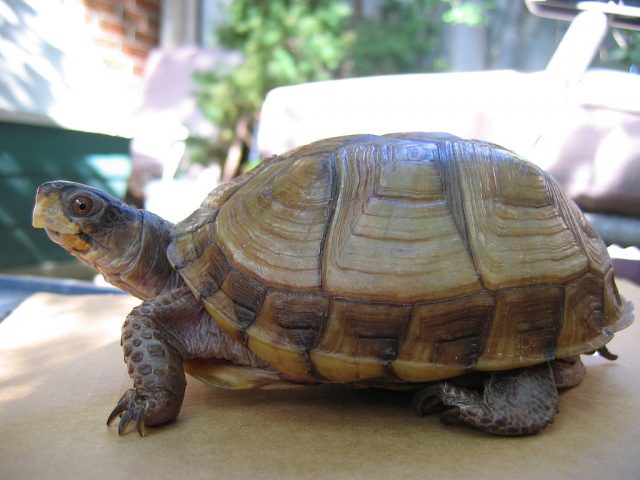| Place of Origin and Range |
From the west to the east of its range, the three-toed box turtle can be found from eastern Texas the northern edge of the Florida Pan-handle. Its northernmost habitat is in Missouri and Kansas, while the southernmost is in Louisiana. |
| Description |
Three-toed box turtles are so named due to the number of toes on the back feet, but some think that there are some 4-toed examples too. However, some speculate that the 4-toed individuals are actually Eastern box turtle × three-toed box turtle hybrids. Three-toed box turtles have a domed shell. The dorsal and limb coloration is commonly completely absent, although some dark blotches are common in adult turtles. These areas more often being a uniform olive green or tan color. Sometimes, faint yellow dots or lines are visible in the centre of each large scute. In the males, the head and throat often display yellow, red, or orange spots. Frequently the bottom shell or plastron is a straw yellow colour. |
| Morph Patterns Available |
Yes |
| Adult Size |
Can grow up to 7in(18cm) |
| Accommodation |
A filtered semi-aquatic cage with water temperature at 70-80'F(21-26'C), and a sloping ramp(driftwood, textured plastic or some other non-abrasive surface) leading from the bottom to an illuminated and warmed basking spot. Approx 80'F(27'C). 2 x 4 feet for an adult. |
| Lifespan |
Can live 20+ years |
| Feeding / Diet |
There are a variety of foods which are universally accepted by turtles, which include earthworms, snails, slugs, grubs, beetles, caterpillars, grasses, fallen fruit, berries, mushrooms, flowers, bread, duck weed, and carrion. |
| Other Considerations |
Being popular in the pet trade, three-toeds are sometimes found well outside of their home range. It is not known whether such captives when released into the wild have any impact on the local species of such areas. These turtles are adaptive, and are possibly the only box turtle who can live happily in an indoor enclosure. Watch for theses health concerns carefully with your turtle. Vitamin A Deficiency: Vitamin A is an important nutrient for your turtle’s health. It is found in his diet in the form of leafy green, orange or yellow vegetables, liver, and fish. If your turtle is not getting enough Vitamin A, he can suffer serious health problems. Always check to make sure that your turtle does not have swollen eyelids, as this is the main sign of a Vitamin A deficiency. Also, check for weight loss, nasal discharge and infected skin. Any of these symptoms could point to a deficiency. If you think your turtle may not be getting enough Vitamin A, you should take him to the veterinarian to get a firm diagnosis. Shell Problems: Your turtle’s shell is very important to his overall health. There are many potential problems that could occur, so you should be on the lookout at all times. Respiratory Disease: Respiratory infections have symptoms similar to vitamin A deficiency, including swollen eyelids and runny nose, so you should take your turtle to the veterinarian to get a proper diagnosis if you suspect either. More serious infections will be characterized by breathing through the mouth, mucus in the mouth, and wheezing. Always make sure your turtle’s environment has the proper amount of humidity, as this will help prevent respiratory problems. |




